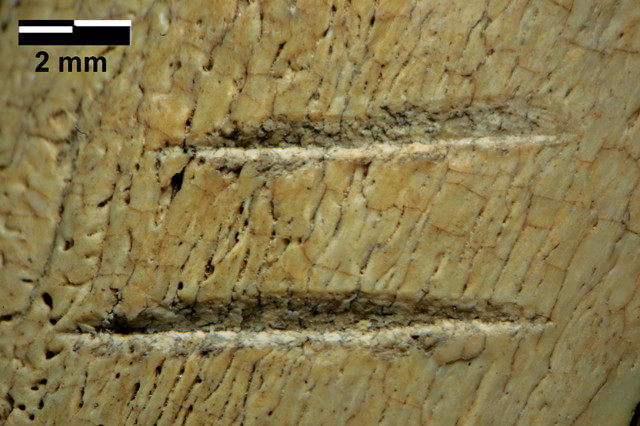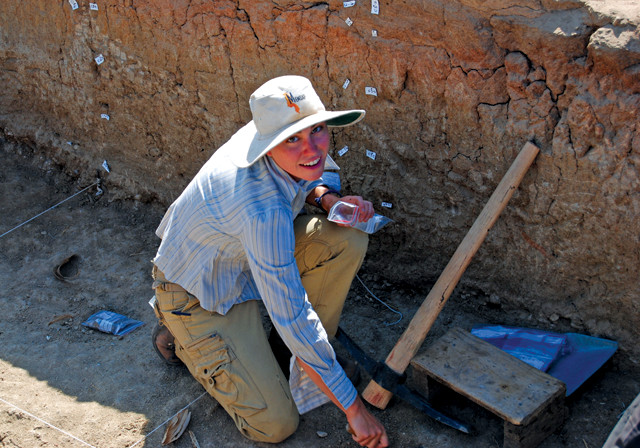
by Mary Caperton Morton Monday, November 2, 2015

Marks on a fossilized rib bone, one of the two controversial bones. Credit: Zeresenay Alemseged.
At some point in early human evolution, our ancestors began regularly hunting, butchering and consuming meat from large game, a protein- and fat-rich change in diet that may have helped fuel the development of a larger and more complex brain. When exactly this change took place has long been a matter of debate. Stone tools from 2.6 million years ago have offered the most solid evidence to date. But the discovery several years ago of a pair of 3.4-million-year-old animal bones in Dikika, Ethiopia, that appear to show cut marks indicative of butchery could push the date back significantly. Some researchers think the bones were marked by incidental trampling, however, not by early humans.
The two bones in question, thought to be a long leg bone from an antelope and a rib bone from a buffalo, collectively bear 12 marks that were originally announced as cut marks from stone butchery tools in a study published in Nature in 2010. That study was controversial because it pushed back the date of stone tool use for butchery by 800,000 years. A 2011 rebuttal published in Proceedings of the National Academy of Sciences (PNAS) claimed the marks had more likely been caused by other animals trampling the bones in abrasive sediments.

Jessica Thompson in the field in Ethiopia, where she and her colleagues collected hundreds of bones in order to study their markings. Credit: Emory University.
In the latest contribution to the debate, published in the Journal of Human Evolution, scientists took a new tack by surveying the Dikika site for additional bones showing evidence of either cut marks or trampling. The team, led by Jessica Thompson, an anthropologist at Emory University, collected and examined a random sample of more than 4,000 bones from the same area as the two marked bones. The researchers also investigated the shape of sand grains at the site, finding that they were mostly rounded — not the angular type that would more likely produce long, straight marks on a trampled bone.
The randomized sampling of bones helped “establish background data for how all kinds of marked fossils look across that landscape,” Thompson says, which allowed the team “to contextualize those 12 marks” described in the 2010 study.
The team then compared 450 marks identified on the randomly collected bones, which dated to between 3.4 million and 3.2 million years ago, to those typical of known trampling damage. Marks on bones left by trampling are usually shallow and curvy, while intentional cut marks left by a stone tool tend to be straight, narrow and V-shaped, Thompson says. The team found that the markings on the randomly collected bones resembled evidence of trampling, but noted that at least two cut marks on the original two bones still stood out as unique. “The marks on the two bones in question don’t look like other marks we found on the landscape,” she says. “The marks are bigger, and they have different characteristics. The best match we have for the marks, using currently available data, would still be butchery with stone tools.”
But the new survey isn’t enough to convince Manuel Dominguez-Rodrigo, an archaeologist at Complutense University in Madrid, Spain, and author of the 2011 rebuttal in PNAS, that the bones were indeed butchered by early humans — in this case, Australopithecus afarensis — as early as 3.4 million years ago. Of the thousands of bones the team collected across the Dikika site, most of them were found “ex situ,” or out of the context in which they were originally buried, Dominguez-Rodrigo says. “There’s no way to know if they come from the same horizon as the original bones,” he says, meaning they can’t necessarily be directly compared to the two bones in question.
Dominguez-Rodrigo says he would like to see the team go back to the site and dig trenches to recover bones from the same layer as the two bones in question. “We need [to identify] the bones in situ so we understand the deposit, so we can better understand the abrasive capabilities of the sediments” in which the bones were found.
“[I] don’t oppose the ideas that there were stone tools or meat eating during the Pliocene, but if that’s true, it would represent a major paradigm change in human evolution,” he says. “We want to be sure that these discoveries are genuine before we accept them.”
© 2008-2021. All rights reserved. Any copying, redistribution or retransmission of any of the contents of this service without the expressed written permission of the American Geosciences Institute is expressly prohibited. Click here for all copyright requests.